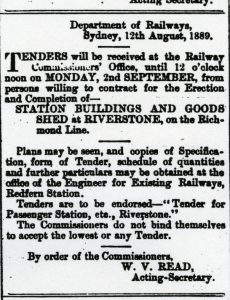by Judith Lewis
On 21st January 1862 the Sydney Morning Herald reported a loan of £60,000 ($120,000) had been authorised for the “a horse railway from Blacktown to Windsor and Richmond”. It was to be the first country branch line to be built in NSW.
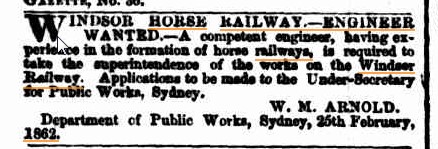
As the ad above shows, in the ensuing year a Horse Railway Engineer was advertised for, a Mr. Weaver, former Colonial Architect, was selected to construct the contemplated lines of horse railway (Apr.) and tenders were called for the “Clearing and Fencing, Windsor and Richmond Line” (May). The line was to be the length of 16 miles, 11 chains and 40 links (approximately 26kms.) and to run from immediately opposite the Blacktown Road Station to “land supposed to belong to William Bowman, adjoining the Market-square in the town of Richmond” (Nov.).

In December that year tenders were called and, on Thursday, 15th January, 1863 a ceremonial turning of the first sod took place at Windsor, with a special train carrying visitors, including the Premier, Charles Cowper; Minister for Works, W.M. Arnold and Captain Ward MLC; from Sydney to Blacktown from whence they were conveyed to Windsor by horse drawn vehicles. A large festive crowd was in attendance, with the day being set aside as a public holiday. Although originally intended to lay down rails for horse traction it was announced that light locomotives would instead be used.
Earthworks for the portion of line between Blacktown and Windsor were contracted in Dec 1862. When they defaulted the contract was awarded to Messrs. Iredale and McNamara (Sept. 1963) and that between Windsor and Richmond to Mr J. Gwyneth. (Dec. 1863). The Chain of Ponds viaduct contract was let to J. Atkinson Jnr. (May 1863) and the South Creek viaduct contract was let to J. Taylor (July 1863) and the permanent way (Mar. 1864) to Messrs. J and B. Thurston. Disastrous floods, higher than any the district had experienced in 45 years, occurred in July 1863, carrying away portions of the banks at South Creek and impeding the work. The total distance from Blacktown to Richmond was 16 miles 19 chains.
Work on the railway offered employment for many men. In September and October 1863 respectively advertisements appeared in the Sydney Morning Herald for “100 good BUSHMEN to split sleepers” and “twenty pair of sawyers, to cut sleepers on the Windsor and Richmond Railway”. By April 1864 contracts had “been taken by Mr. Elphinstone for the erection of the stations and goods sheds at Windsor and Richmond” and there would be signal stations at Eastern Creek (Riverstone) and South Creek (Mulgrave). A sum of £15,000 was “placed on the additional estimates for 1864, for completing the Windsor and Richmond railway” £5000 for three locomotives and £10,000 to cover the cost of altering the line from a horse railway to a locomotive one. In October 1864 tenders were called for stations at Riverstone, Mulgrave, Windsor and Richmond and for seats at Windsor and Richmond railway stations.
The Sydney Morning Herald of 30th November 1864 reported “the branch railway from Blacktown… to Windsor and Richmond was officially opened yesterday”. This was a preliminary to the public opening on 1st December. “In order that the gratifying and auspicious event might be fittingly celebrated, invitations… had been sent to his Excellency the Governor and suite, the Ministry, the Members of the Legislative Council and of the late Assembly, a number of Government officials, and other gentlemen”. “Spirited preparations had been made, both at Windsor and Richmond… showing that the inhabitants of the Hawkesbury district properly appreciated the advantages they are about to derive from railway communication with the metropolis”.
The special train left Sydney shortly before 10 o’clock, arriving at Blacktown Junction about 10:40am. At Blacktown the train was divided into two portions, one part preceding the other “at a tolerably rapid pace”. The Herald describes the scenery as “forest land…where cattle were seen depasturing in the thickly growing grass” the train winding “its way between numerous gentle eminences whereon the trees were less numerous…the herbage more and more infrequent. Long reaches of level lands came next, where the swampy oak, mingled with the eucalyptus and bush scrub, showed the land was swampy and poor… chains of ponds by the roadside…lofty wooden bridges, spanning sluggish and insignificant creeks…fine rolling country once more, some in its natural state and some cleared and under cultivation. Snug little farms with their green peach orchards, their gardens and their haystacks – the well pleased owners and their families running out to give a welcome to the steam horse…and so the first railway train came at last into the Hawkesbury district and was received with loud shouts by the assembled population of Windsor”.
The Windsor folk “had made all due preparations” expecting the train to stop at Windsor to “let them see the Governor, the members of parliament and the other celebrities”. “Numbers of them were quite ready then and there to ride on to Richmond in the first train” but “the iron horse…did not stop at Windsor, but rushed with unabated speed to Richmond”. “On leaving Windsor…there was for the most part open country…alluvial land under cultivation, comfortable English looking homesteads, with adjacent shady trees and distant mountain scenery”.
The train came into Richmond at about 11:30am and “with loud cheers, as at Windsor, the pretty little village of Richmond” welcomed the visitors. Mr George Bowman, chairman of the Reception Committee, read the address, which he then passed to the Governor Sir John Young, marking the event as “of vast importance to the prosperity of our District”. Sir John responded, “… I rejoice that railway communication has been opened between the metropolis and this charming district.” The official party then “visited the residence of Mr. William Bowman, and drove through the village, which presented a gay and festive appearance. On the green the tall wiry yeomen and shapely bright eyed lasses of the Kurrajong district, mounted on their rough-looking fast-going horses, collected in large groups”. Others gathered round a roasting ox, visited the church and churchyard or the inn close to the station.
The train had returned to Windsor to collect those people wishing to travel to Richmond and upon their arrival the breakfast was commenced. The train travelled to and from Windsor several times during the early part of the day. With free passage on offer, many availed themselves of the opportunity.
The official party and several others, at 12 o’clock, enjoyed “an excellent breakfast laid out in the goods shed”. Many of the Sydney people then travelled back to Windsor and “sauntered the little capital of the Hawkesbury”, where the official dinner was to be held that evening. Politics came into the picture when “a number of influential residents” assembled in front of McQuade’s hotel, read and presented an address, signed by 60 or 70 gentlemen, to the Honourable Charles Cowper, M.L.A, Member for East Sydney. Mr. Cowper responded thus. “…The undertaking was commenced by my colleagues and myself, and was far advanced towards completion before we left office”. (Nothing much has changed in the past 150 years?) Elections must have been in progress for he further commented, thanking them for their congratulations on the results of the Sydney elections and hoping that the country electorates would “follow the example of their Sydney friends”.
The dinner that evening, in Windsor, took place in the School of Arts, “at the lower end of town…The viands were provided by Mr. Cripps ” with the Member for Windsor, Mr. Walker, taking the chair. The usual toasts followed – to the Queen (Victoria), the Prince of Wales and the other members of the Royal family, the Governor, Sir John Young, the prosperity of the Windsor and Richmond railway, the health of Lady Young and the ladies of the colony and, finally, the Parliament of the Colony. Each toast was duly followed by an appropriate musical air. Mr. Cowper, in responding to the final toast, let it be known that he “had taken a deep interest in the promotion of railways in this colony, and had done so as long ago as 1846 and … might truly say they owed much to him for the progress of railways in the colony, and their special extension to that district”. (A true politician?)
This terminated the proceedings at the dinner. The Governor and many guests then proceeded to the railway station to return to Sydney. A ball, commencing shortly after 8pm., was held at Cadell’s Brewery, in one of the cross streets. Master of Ceremonies was Mr. W. Clark.
The railway was open to the public on Thursday, 1st December. A sale, on Saturday 3rd December, was held for the Riverstone Estate, as land was available on both sides of the railway that “now runs through the estate”. “Long credit” was on offer, as was “short and perfect title”.
In December the SMH advertised that day excursion trains to Riverstone, Mulgrave, Windsor and Richmond would leave Sydney at 9:00am and 11:00am and return from Richmond at 4:00pm and 6:45pm, calling at all stations.. The offer was available for 24th, 25th, 26th and 27th of December. Fares from Sydney to Riverstone were for 3 classes and were 18 shillings ($1:80), 10s. & 6d. and 5s. & 6d. Trains leaving Sydney at 9:00am were scheduled to arrive at Riverstone at 10:30am. The earliest available public timetable, 1st September 1866 showed 2 return trips each weekday, 1 on a Saturday and 2 on a Sunday.
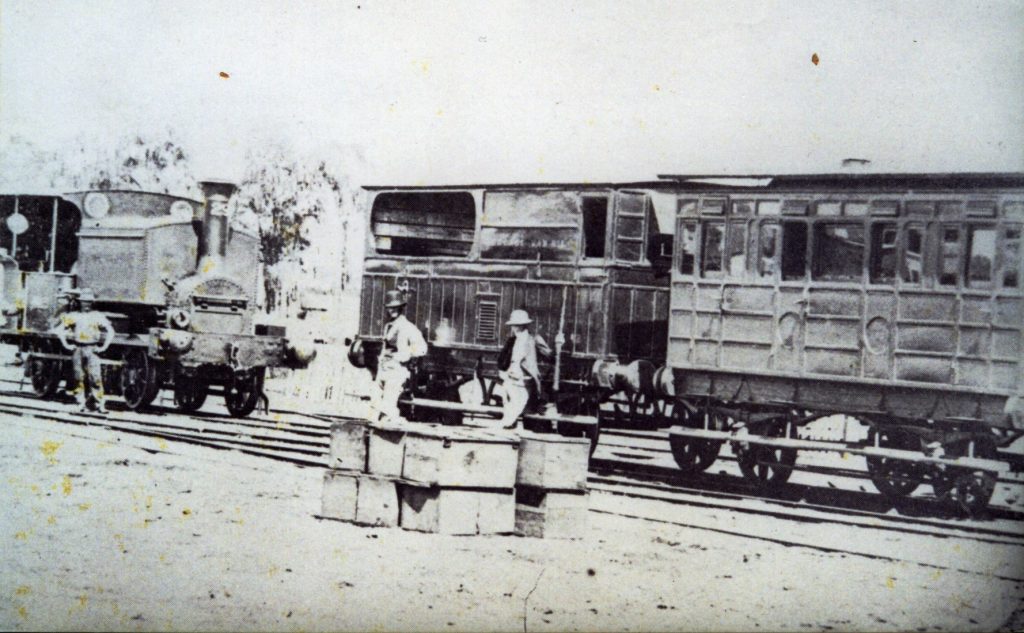
The photo above dates to about 1867 and shows one of the original Richmond Line trains. Locomotive No 29 is seen with a luggage van and second class passenger car. The photo and information from The Railway News October 1989. Photo SRA Archives, ref. PR. 863B.
| ADDENDUM: This photo would have been taken some time between 1872 and 1876. The locomotive was rebuilt with the larger saddle tank in 1872, and in 1876 it was transferred to one of the Tramways and was fitted with a longer chimney. Other data from the early carriages tends to indicate that this is more likely about 1875-1876. (Information courtesy Martin Hartley via email 6 February 2022.) |
According to the Hawkesbury Historical Society Web page, Engine No. 29 was originally Engine No. 15 and was named Windsor until 1865. (The engine was scrapped in 1923.)
If you would like to see a locomotive and the type of carriages used on the Richmond line, Locomotive No 1 is on display at the Sydney Powerhouse Museum. Between 1857 and 1887, this locomotive was used mainly for hauling goods and passengers between Sydney, Campbelltown, Richmond and Penrith. (Locomotive No 1 by Margaret Simpson Powerhouse Museum.)
The 1867 June flood, the largest on record, (it was stated a boat could be taken from Riverstone to the Blue Mountains – 15 miles, or from Pitt Town to Kurrajong – 20 miles) caused havoc along the line. Only 2 houses escaped the flood in Riverstone and the railway engine could not approach within half a mile of the Riverstone station.
Two days after rail communication ceased the stationmaster at Blacktown received a message that 9 people were surrounded by water at Riverstone and in great danger. A special engine, with 2 boats, was sent. A mile from Riverstone it was unable to go further so the boats, with Mr. Owen, railway manager and Mr. Collins, Blacktown stationmaster, each in charge of a boat, pulled to the home of farmer Mr. Carberry, his wife and 5 children who were in the attic of their home where they had removed shingles and were waving a white sheet and firing guns.
This flood saw the timber viaduct completely covered by floodwaters and the line closed for considerable time. It was replaced by a higher structure in the mid 1870s and remained in use until a steel girder structure on concrete piers, was built for the electrification project in 1984. In 1987 the Chain of Ponds (Rickabys Creek) timber viaduct was replaced by a pre-stressed concrete bridge.
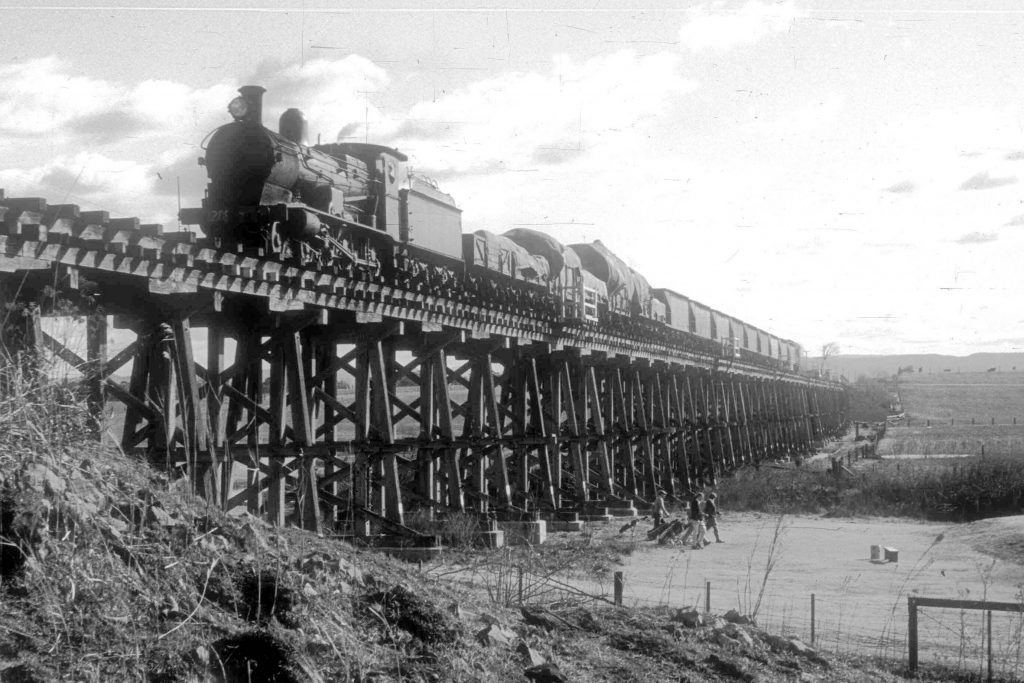
From the time of the opening of the line Riverstone was provided with a station and a loop siding. The platform, adjacent to the loop siding, was of brick construction. A single brick building housed the booking office, waiting room and a residence for the stationmaster. At the northern end of the loop, a dead-end siding served as a goods siding and a loading point for timber from the adjacent mill. Riverstone became the busiest of all the stations along the line with several sidings added, the first of these, in 1879, was to serve the abattoir established by Ben Richards. It came to be known as Richards’ Siding. At its busiest there was 6996ft. of siding space within the meatworks complex.
In 1880 a new station building was constructed at Riverstone. All railway functions were transferred there and the original structure became the Post Office, which it was to continue as till 1942 when the present one was completed. The Station Master had to man the Post Office until 1879 when a Post Master was appointed.
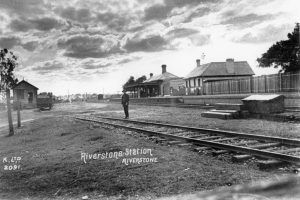
can be seen in the distance.
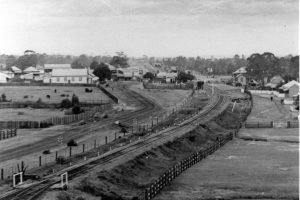
In 1916 the loop siding was extended and became the platform loop and the goods siding was renamed the stock siding. A new goods’ siding was constructed on the western side of the station opposite the platform and a goods’ shed was built to protect freight either awaiting despatch or pick up. The water tower at the gates’ end of the Riverstone station first appeared on maps in 1916. It is not known exactly when it was built but it may have been as early as 1894 when the meatworks built the first weir across Eastern Creek behind the works. The railway tank was filled with water from the meatworks supply.
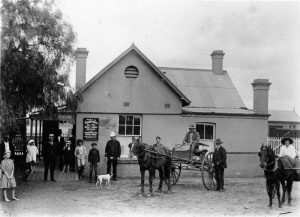
In July 1939 a new platform was constructed on the western side. In September 1944 the crossing loop and platform were extended and Richards Siding, instead of making its junction with the main line, was connected with the goods’ siding.
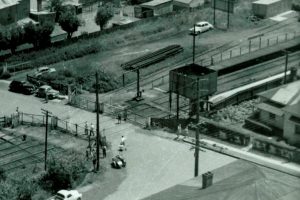
The 1956 photo above shows the two platforms and the wooden railway gates. The station master’s house was located close to the railway crossing to allow the station master to open/ close the gates for trains or cars. The photo shows the water tank used for filling the steam locomotives with water.
In 1968 flashing lights and half-boom gates were installed at the Garfield Road level crossing. These have been upgraded several times, the most recently when the traffic lights were installed.
Other Stations along the Blacktown – Richmond Line were erected as follows:-
Marayong, an aboriginal word meaning “emu” was opened on 2nd November 1922. The original platform of 270ft. (approx. 80 metres) was eventually extended to 453ft.
Quakers Hill was originally known as Douglas Siding with a small wooden platform constructed in 1872. On 30th March 1905 the name was changed to Quakers Hill, after a local geographic landmark. On 22nd June 1939 Quakers Hill became a staff station with a crossing loop with a small platform provided on the crossing loop. During World War 11 intermediate signals were installed between Quakers Hill and Schofields as the line passed along the eastern extremity of HMAS Nirimba airbase, particularly runway No. 3.
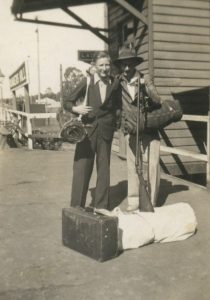 |
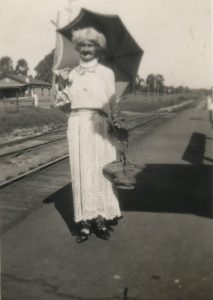 |
Schofields station opened in 1870. It was named for John Schofield, local landowner and was known then as Schofield’s Siding. A goods’ loop siding was laid on the topside of the main line opposite the platform. The goods’ siding was abolished on 27th August 1973. On 29th October 2011 the controversial new Schofields Station was opened on a new site and the original one demolished.
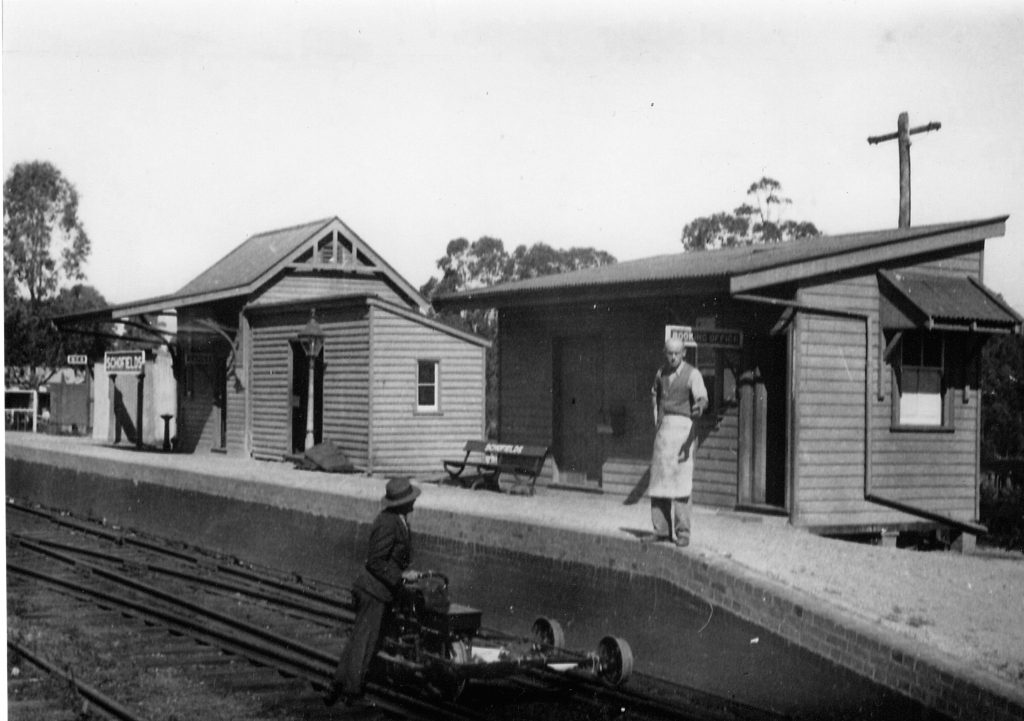
Vineyard was named for the vineyards there. The platform was opened on 17th July 1935. The only protection from the elements was, and still is, a waiting shed.
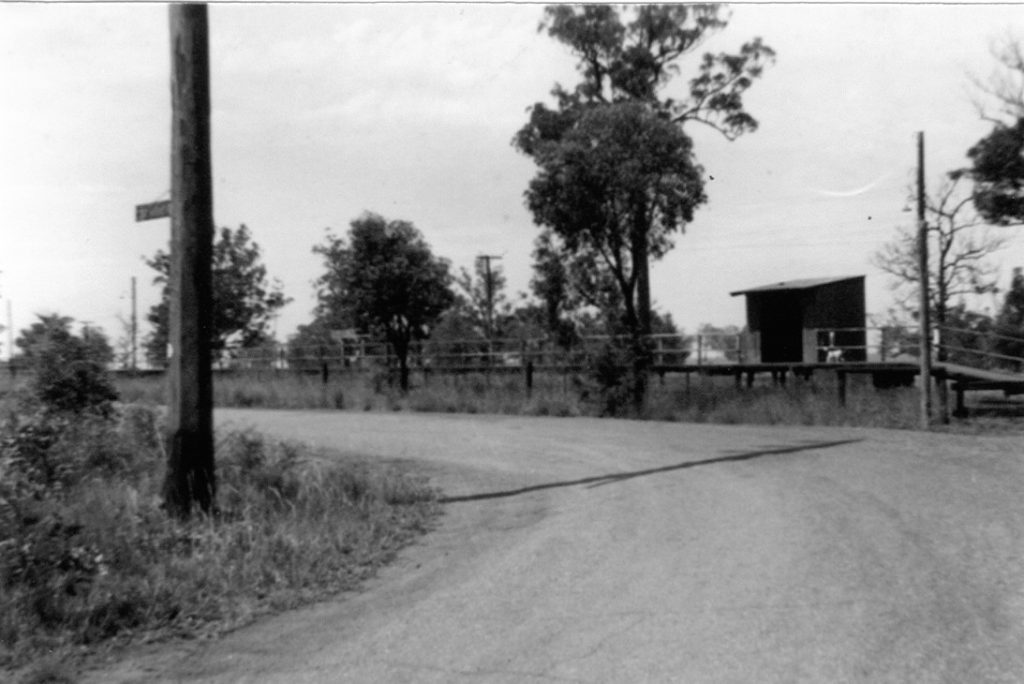
Mulgrave was named after Baron Mulgrave, an English statesman. The station was provided from the time of the opening of the line, with a loop siding installed on the up side of the main line, a goods’ siding at the Blacktown end and another short dead-end at the Richmond end. The platform was stationed on the loop siding. A single station building, partitioned into a waiting room, booking office and stationmaster’s accommodation, was constructed adjacent to the platform. In 1900 the original platform was demolished and replaced by a larger structure complete with a station building and two outbuildings. The earlier building then became a residence. A goods’ shed and cattle race were added. In 1912 a new brick platform, on the eastern side of the level crossing, replaced the 1900 structure, the loop siding became a goods’ siding and Mulgrave became an island platform. In 1922, between the viaduct spanning South Creek and Windsor, a siding was erected, serving the Windsor Milk Company (later known as the Hawkesbury Dairy and Ice Company).
Windsor’s original platform was replaced in 1883 by a larger brick structure, which remains in place today. A goods yard consisting of two short sidings was located at the north – western end of the station. Around the turn of the century George Street was diverted to the east, passing under the railway, which now spanned the relocated roadway via a timber trestle bridge. In April 1995 a new bridge of steel girders replaced the timber bridge.
Clarendon was originally known as Hawkesbury Racecourse. In 1876 a new platform was built “to serve the punting public”. It was named Clarendon after a local property owned by G. Evans. It had a crossing loop and a long goods’ siding. Clarendon underwent many alterations during World War 11 to allow for additional traffic to the airbase.
East Richmond was opened in July 1939 to allow residents in that growing part of town easier access. It was only 27chains (just over ¼ of a mile) east of Richmond.
Richmond, in similar fashion to the other original stations, consisted of a waiting room, booking office and station master’s residence. An engine run-round loop was provided on the southern side, opposite the platform. Being the terminus of the line, the yard at Richmond was large with a locomotive depot, goods’ yard, a turntable and numerous sidings.
In June 1923 work commenced on the line to Kurrajong. The line, built around the back of the original platform, crossed East Market, passed through the park and continued down March Street on its way to Kurrajong. This line opened on 20th November 1926. The weather led to its line closure in July 1952 after several periods of heavy rainfall in quick succession caused several landslips that severed the line. There were stations at North Richmond (1926), Phillip (1928) and Kurrajong (1926) and Halts at Red Cutting, Kemsleys, Thompsons Ridge, Nurri and Duffy (all 1928).
Significant Dates of Richmond Railway Line History
-
- 1878 – Timetable of 6th July shows dedicated goods services scheduled on the line. The first timetabled crossing of trains was planned.
On a Saturday evening No. 4 down passenger train crossed No. 3 passenger train at Mulgrave. - 1883 – An additional early morning train, arriving at Richmond at 1:45am, took late night revellers home.
- 1893 – The 18th December timetable introduced through trains from Sydney terminal and Parramatta. Pick-up goods trains were mixed trains allowing the carriage of passengers between Clyde and Richmond. A fast meat train was timetabled daily, except Sunday, between Riverstone and Darling Harbour
- 1939 – 17th July, the second platform was opened.
- 1954 – Line to Blacktown electrified. Steam trains continued to operate to and from Sydney to Richmond in peak hours. In off peak hours rail motors were used between Blacktown and Richmond.
- 1969 – 25th October saw the last steam-hauled service to Richmond. Diesel-electric locomotives hauled the goods trains. The last stock trains into the meat works ceased in the late 1960s and the last refrigerated meat train in the1970s
- 1975- 22nd May the first electric train arrived at Riverstone and diesel rail cars continued the service from Riverstone to Richmond.
- 1991 – Electrification of the line to Richmond was completed.
- 1878 – Timetable of 6th July shows dedicated goods services scheduled on the line. The first timetabled crossing of trains was planned.
Bibliography
PHILLIS, Rosemary compilation., The Railway at Riverstone, Riverstone and District Historical Society, 2003.
PHILLIS, Rosemary compilation., Richmond Line Newspaper References 1862-1889, Riverstone &m District Historical Society.
ATTENBOROUGH, Peter and others, Byways of Steam 24, Sydney, Eveleigh Press, 2005.
(Byways of Steam 24 contains a comprehensive history of the Richmond Branch Line and many photographs. Copies are available for sale through a number of sources including the New South Wales Rail Transport Museum phone: (02) 4681 8001 or e-mail retailsales@nswrtm.com.au.)

